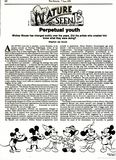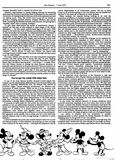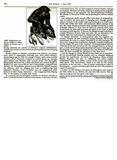AGE OFTEN turns fire to placidity. Lytton Strachey, in his incisive portrait of Florence Nightingale, writes of her declining years: "Destiny, having waited very patiently, played a queer trick on Miss Nightingale. The benevolence and public spirit of that long life had only been equalled by its acerbity. Her virtue had dwelt in hardness. . . . And now the sarcastic years brought the proud woman her punishment. She was not to die as she had lived. The sting was to be taken out of her; she was to be made soft; she was to be reduced to compliance and complacency."
I was therefore not surprised — although the analogy may strike some people as sacrilegeous — to discover that the creature who gave his name as a synonym for insipidity had a gutsier youth. Mickey Mouse turned a respectable 50 last year. To mark the occasion, many theatres replayed his debut performance in Steamboat Willie (1928). The original Mickey was a rambunctious, even slightly sadistic fellow. In a remarkable sequence, exploiting the exciting new development of sound, Mickey and Minnie pummel, squeeze, and twist the animals on board a steamboat to produce a rousing chorus of Turkey in the Straw. They honk a duck with tight embrace, crank a goat's tail, tweak a pig's nipples, bang a cow's teeth as a stand-in xylophone, and play bagpipe on her udder.
Christopher Finch, in his semi-official pictorial history of Disney's work, comments: "The Mickey Mouse who hit the movie houses in the late 1920s was not quite the well-behaved character most of us are familiar with today. He was mischievous, to say the least, and even displayed a streak of cruelty" (The Art of Walt Disney, 1975). But Mickey-soon cleaned up his act, leaving to gossip and speculation alone his unresolved relationship with Minnie and the status of Morty and Ferdie. Finch continues: "Mickey ... had become virtually a national symbol, and as such he was expected to behave properly at all times. If he occasionally stepped out of line, any number of letters would arrive at the Studio from citizens and organisations who felt that the nation's moral well-being was in their hands . . . . Eventually he would be pressured into the role of straight man."
As Mickey's personality softened, his appearance changed in tandem. Many Disney fans are aware of this transformation through time, but few (I suspect) have recognised the coordinating theme behind all the alterations — in fact, I am not sure that the Disney artists themselves explicitly realised what they were doing, since the changes appeared in such a halting and piecemeal fashion. In short, the blander and inoffensive Mickey became progressively more.
[…]


